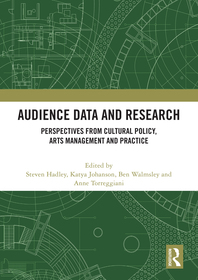
Audience Data and Research
Perspectives from Cultural Policy, Arts Management and Practice
- Publisher's listprice GBP 42.99
-
20 538 Ft (19 560 Ft + 5% VAT)
The price is estimated because at the time of ordering we do not know what conversion rates will apply to HUF / product currency when the book arrives. In case HUF is weaker, the price increases slightly, in case HUF is stronger, the price goes lower slightly.
- Discount 10% (cc. 2 054 Ft off)
- Discounted price 18 484 Ft (17 604 Ft + 5% VAT)
Subcribe now and take benefit of a favourable price.
Subscribe
20 538 Ft

Availability
Estimated delivery time: In stock at the publisher, but not at Prospero's office. Delivery time approx. 3-5 weeks.
Not in stock at Prospero.
Why don't you give exact delivery time?
Delivery time is estimated on our previous experiences. We give estimations only, because we order from outside Hungary, and the delivery time mainly depends on how quickly the publisher supplies the book. Faster or slower deliveries both happen, but we do our best to supply as quickly as possible.
Product details:
- Edition number 1
- Publisher Routledge
- Date of Publication 6 May 2025
- ISBN 9781032632445
- Binding Paperback
- No. of pages190 pages
- Size 246x174 mm
- Weight 350 g
- Language English 659
Categories
Short description:
This book presents a wide range of new audience studies research in the performing arts to provide a diversity of perspectives from scholarship, policy, management and practice. It was originally published as a special issue of Cultural Trends.
MoreLong description:
This book presents a wide range of new audience studies research in the performing arts to provide a diversity of perspectives from scholarship, policy, management and practice. It explores the insights different methodologies, carried out with different kinds of audiences, can contribute both to our immediate understanding of audiences and to the future development of audience research.
The book showcases research across the myriad fields that contribute to audience scholarship, highlighting the ability of audience research to engage thinkers and practitioners, from across often falsely divided art forms and academic fields. Together in one volume, these different methodologies explore the potential complementarity of evolving approaches to audience research and provide an in-depth opportunity for investigating innovative methods. Focusing on the need to understand audiences in a deeper and richer way, this volume offers a crucible of thinking and re-thinking about how society understands the impact of arts and culture on audiences.
Audience Data and Research: Perspectives from Cultural Policy, Arts Management and Practice serves as a catalyst to stimulate new critical debate on the potential of empirical audience research to provide fresh insights into questions of audience enrichment and cultural value. It will be a key resource for scholars and researchers of audience studies, media and cultural studies, performance arts research, arts management, and cultural policy. This book was originally published as a special issue of Cultural Trends.
MoreTable of Contents:
Introduction: Reflections on Audience Data and Research 1. A prison audience: women prisoners, Shakespeare and spectatorship 2. Challenges of cultural industry knowledge exchange in live performance audience research 3. Using mixed-methods, a data model and a computational ontology in film audience research 4. SROI in the art gallery; valuing social impact 5. Arts audience segmentation: data, profiles, segments and biographies 6. The work of the audience: visual matrix methodology in museums 7. A possible teleology of cultural sector data in England 8. The coming crisis of cultural engagement? Measurement, methods, and the nuances of niche activities 9. Spontaneity and planning in arts attendance: insights from qualitative interviews and the Audience Finder database 10. Measuring the effectiveness of public subsidy by the analysis of disparate data sources: do subsidies increase arts participation by low engagers?
More



